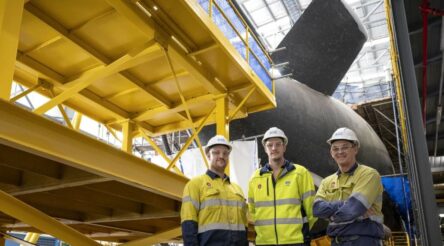US confirms Australia as a site of missile manufacture

Australia and the United States have stepped up their co-operation in the establishment of second source manufacturing capabilities for guided weapons in Australia.
With the US and allies shocked by the rapid depletion of key missiles and artillery shells in Russia’s invasion of Ukraine, the progress was announced by the governments of Australia and the United States of America following Australia-United States Ministerial Consultations (AUSMIN).
Minister for Foreign Affairs Penny Wong and Deputy Prime Minister and Minister for Defence Richard Marles hosted the U.S. Secretary of State Antony J. Blinken and Secretary of Defense Lloyd J. Austin III in Brisbane to advance the Australia-U.S. Alliance and the AUKUS pact.
Their joint statement said: “The principals agreed to deepen cooperation on Australia’s Guided Weapons and Explosive Ordnance Enterprise by collaborating on a flexible guided weapons production capability in Australia, with an initial focus on the potential for co-production of Guided Multiple Launch Rocket Systems by 2025.
“This is key to expanding the combined industrial power of the Alliance and to building Australia’s industrial infrastructure and skilled workforce.”
The carefully worded communique did not go as far as earlier media stories that claimed unequivocally that the US would buy Made in Australia missiles, but it did lay the groundwork for Australia as a second source producer from 2025.
US manufacturers Lockheed Martin and Raytheon are assembling a network of suppliers to create the GWEO, which following the Defence Strategic Review was allocated $2.5 billion in funding.
At a subsequent media conference Marles said: “We are really pleased with the steps that we are taking in respect of establishing a Guided Weapons and Explosive Ordnance Enterprise in this country.
“And doing so in a way where we hope to see manufacturing of missiles commence in Australia in two years’ time as part of a collective industrial base between our two countries.
“And this represents a very, very significant step forward in our relationship, and in the relationship of our defence industry.”
The ministers and officials discussed and vigorously agreed on positions across the gamut of international defence, trade and societal issues including the urgency of climate change.
Specifically they agreed on the stationing US reconnaissance planes in Australia, establishing a US logistics hub in Queensland, more visits from US SSN submarines, the establishment of a Combined Intelligence Centre – Australia within Australia’s Defence Intelligence Organisation by 2024 and upgrading Australia’s northern defence bases.
Building up supply chains for explosives ordinance was also discussed.
The communique said: “The principals reaffirmed their commitment to address global supply chain constraints and to transfer technical data for the M795 155mm artillery shell in support of future production in Australia.
“They reaffirmed their commitment to progress the maintenance, repair, overhaul, and upgrade of priority munitions in Australia, noting this would enhance supply chain resilience, with an initial focus on MK-48 heavyweight torpedoes and SM-2 missiles.”
The ministers and officials welcomed progress under the AUKUS partnership towards Australia’s acquisition of a conventionally armed, nuclear-powered submarine capability.
At a subsequent media conference Marles said: “We will be seeing an increased tempo of visits from American nuclear-powered submarines to our waters as we look towards the establishment of a US submarine rotation at HMAS Sterling later in this decade.”
In terms of Force Posture Initiatives, the meeting agreed that space cooperation would now form a key part of what the two nations do in our military and defence cooperation.
“They welcomed the embedding of Australian Government personnel within the U.S. submarine industrial base and Australians deployed on U.S. submarines as a way for Australia to progressively develop the skills, knowledge, and expertise required to operate, maintain, and steward nuclear-powered submarines under the AUKUS Optimal Pathway.”
Further reading:
$4.1 billion for guided missiles, $2.5bn for local manufacture
Lockheed Martin, Thales advance GWEO manufacturing ambitions
Picture: Kongsberg naval strike missile
@aumanufacturing Sections
Analysis and Commentary Awards Defence Manufacturing News Podcast Technology Videos










